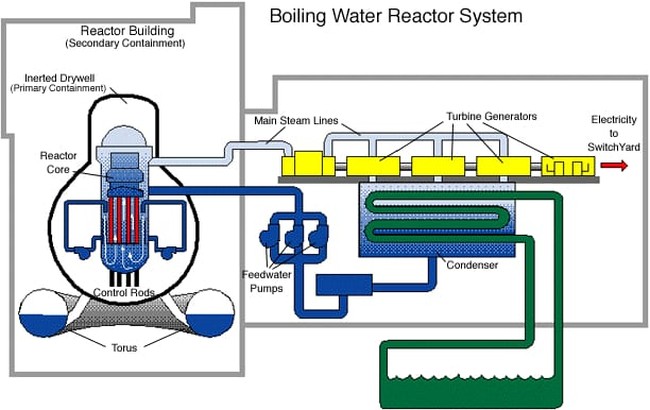The March 11 earthquake off the coast of Japan has been an unprecedented disaster. Now estimated to have been a magnitude 9 earthquake — one of the top five earthquakes measured since reporting started in 1900 — it was the result of a “megathrust” in which an area of sea floor bigger than the state of Connecticut broke free and moved under the force of colliding tectonic plates. It was so strong that it literally moved the entire island of Honshu eight feet to the east. The earthquake was then followed by a tsunami comparable to the Boxing Day tsunami of 2004 — but since the epicenter of the quake was only a few miles off the coast of Japan, the tsunami struck the heavily populated coast of Honshu with almost no warning, basically washing many coastal villages off the face of the earth.
The earthquake and tsunami seriously damaged reactors at the Fukushima Daiichi (“number one”) and Daini (“number two”) in Okuma, in Fukushima Prefecture, and also damaged the Onagawa plant in Miyagi Prefecture. In total, of the 55 nuclear power generation plants in Japan, 11 have been forced to shut down, cutting power generation capacity in Japan dramatically and forcing the country to adopt a series of rolling blackouts. It would seem impossible to overstate the severity of the crisis.
The media, however, has risen to the challenge, with a combination of poor information, ignorance, and alarmism, along with antinuclear activists passing themselves off as unbiased experts.
Let’s try to make some sense of it all.
Basics of How Reactors Work
The Fukushima plants have several reactors built on the same basic design, either by GE or by Japanese companies licensed by GE. These are all “boiling water” reactors, which means just what it sounds like: the heat of the nuclear reaction boils water; the steam generated is used to drive turbines and thereby generate power. The water in direct contact with the reactor core known as “coolant” is nothing particularly special, just demineralized; water itself isn’t very susceptible to becoming radioactive, but minerals and contaminants in the water can be. If the water is purified, there’s less radioactive waste to deal with.
The cooling water is pumped past the reactor core in normal operation to get the energy with which power is generated, and of course to cool the core. If there’s an accident, the reactor is shut down by inserting the “control rods,” made of some material that absorbs neutrons and so slows the nuclear fission from which the reactor gets its power. Even a shut down reactor continues to need cooling, however; there’s an immense amount of residual heat still left in the reactor core. This means continuing to run the pumps, and of course with the reactor shut down they can’t be run from the reactor’s power, so there are diesel generators as a backup, and batteries as a further backup to the generator.
If all the cooling fails for some reason, the accumulated heat can’t escape; the water boils away, and once it’s gone, the materials that make up the reactor core break down. This is a Bad Thing, because the controls on the reactor fuel also break down; it starts to heat up again. This is what’s called a meltdown. When this happened at Chernobyl, the reactor core quickly became hot enough to vaporize the reactor’s fuel and a good part of the other material around it, leading to an explosion that destroyed the building that housed the reactor.
To prevent that from happening in commercial reactors in the capitalist bloc, the reactor is inside three concentric safety vessels: first, the “boiler” itself; second, a massive steel bottle; and third, an even larger and more massive reinforced steel, concrete, and graphite outer containment vessel. In case of a meltdown, the whole reactor should be contained within the steel secondary containment vessel, but if it’s not, the molten reactor core drops to the graphite floor of the third vessel, where it spreads out across the floor. This causes the reactor to stop, and it can cool naturally. Eventually the pieces can be cleaned up.
This whole structure is then inside a big conventional steel building that is the outside wall of the reactor complex.
What happened at Fukushima Daiichi
The original earthquake hit. Three of the six reactors were in operation, the other three were shut down for scheduled maintenance. The reactors were designed to sustain an earthquake of magnitude 8.2; at magnitude 9, the Honshu quake was 16 times more powerful. This caused the plant to automatically shut down; this was apparently successful, but …
About an hour later, the tsunami hit. The tsunami did two significant things: it destroyed the backup generators that kept the pumps running, and it apparently so contaminated the reserve coolant that it was not only no longer pure, but was so mucked up with the scourings of the tsunami that it couldn’t be safely pumped. At this point, the reactor was in some trouble.
As the reactor heated up, water began to react with the zirconium fuel-rod containers, liberating hydrogen, which started to build up in the boiler. The operators began to vent gases from the reactor to reduce the pressure, liberating the hydrogen into the outer façade building. These gases are mildly radioactive, mainly with nitrogen-16 and several isotopes of xenon, all products of the fission reaction that powers the reactor; apparently they were vented into the outer building in order to slow their dispersion and give them a chance to lose radioactivity.
Hydrogen in combination with the oxygen in the air can be explosive, and at some time after the venting started in reactor 3, the hydrogen in the outer façade exploded, blowing off the walls of upper half of the building and leaving the steel structure exposed. This explosion put six workers in hospital, with various injuries and one apparent heart attack. This was the first spectacular explosion that raised great clouds of white smoke.
This was reported in the New York Times as “radiation poisoning.” No other source has reported this, including the IAEA. Apparently, according to the Times, radiation poisoning breaks arms.
The second explosion was another hydrogen explosion; as before, apparently what was destroyed was the outer building that surrounds the containment, not the containment itself.
Confusion
This is the point at which the media confusion starts. Many stories concentrating on the reactor accidents were illustrated with blazing pictures of a natural gas plant explosion and a burning oil refinery, much more visually impressive than a building with the façade stripped off, but giving the false impression of a blazing inferno at the reactors.
Several headlines said “nuclear explosion,” which is something very different from “an explosion in a nuclear power plant.”
Anti-nuclear politicians like Congressman Ed Markey and anti-nuclear activists from groups like the Institute for Policy Studies warned ominously of “another Chernobyl” — which this isn’t and never will be; the reactors are wildly, radically, different in design. (More on this below.)
Television talking heads talked about the “containment building.” Which is strictly true, since the building in which the containment is housed would be the “containment building” — but misleading and confusing, because the containment for all three reactors remained intact.
So there’s the first bottom-line point: at least so far, the inner, steel, containment vessel on all three Fukushima reactors remains intact.
Radiation
When the gases started to be released from the containment vessels, that meant there was some release of radiation. With their usual nuance, the media reported only that there was radiation released; since there was detectable radioactivity on the clothes and bodies of the men injured in the explosion, this apparently turned into “radiation poisoning,” even for the poor guy who had the heart attack.
But how much radiation was really released? There are several ways to measure radiation, but what we’re usually concerned with is the dose received — that is, how much radiation has hit the body of someone who gets exposed. It can be thought of like sunburn — if you’re out in strong sunlight for fifteen minutes, you are getting a “small dose” of sun; four hours, and you get a “big dose” and may get a sunburn.
In the U.S., this is usually measured as Roentgen, named for the discoverer of X-rays. (Strictly, it’s measured as “Roentgen absorbed dose” or rad, and the dose in humans is “Roentgen equivalent in man” or rem, but for our purposes it’s close enough to say 1 Roentgen = 1 rad, = 1 rem.) In the rest of the world, dose is measured in Sievert, with 100 Roentgen to 1 Sievert. A whole-body dose of 6 Sievert or 600 Roentgen is called the “LD 50/30 dose,” meaning that 50 percent of the people who get that dose will die within 30 days.
The highest dose rate — that is, the dose received in a period of time — that was observed around the Fukushima reactors was about 1015 microSeiverts per hour, but rapidly dropped to about 70 microSeiverts per hour. In other words, 0.001015 Sieverts per hour, or about 0.1 Roentgen per hour. The highest total body dose reported so far has been 106 milliSieverts, 0.106 Sieverts, or about 10 Roentgen.
What does this mean? Well, in the U.S., the average background radiation is around 7 milliSieverts (700 milli-Roentgen) a year; we here in Colorado nearly double that (more in some places, like Leadville) and some places have a background radiation of 50 times that or more.
So 1015 microSieverts is pretty significantly above normal background radiation, but that’s not the whole story either. By comparison, a CT scan exposes you to about 5 milliSieverts, 0.5 Roentgen; the total dose of the highest exposure reported has been about 20 CT scans. High altitude commercial flights have more radiation than normal background; 10 Roentgen is about twice what a intercontinental flight attendant gets in a year.
Effects of radiation
There’s no question that the effects of big doses of radiation are pretty awful; various systems break down, you can’t absorb food — in fact, vomiting and diarrhea are some of the first symptoms, along with hair loss — and eventually, your immune system fails and you die as a result of massive infections, or hemorrhaging, or dehydration. These effects are known as acute radiation syndrome, ARS.
Low levels of radiation are another thing. Obviously, we all are exposed to some radiation because of the normal background. The usual model, based on the people affected in Hiroshima and Nagasaki, and later Chernobyl, is called a “linear dose response model,” and assumes that if a dose of 100 rem causes there to be 10 percent more deaths in a population, then a dose of 10 rem will mean 1 percent more, 1 rem about 1/10th of one percent more, and so on.
This is a conservative model, but it has a problem — it predicts that places with high background radiation, like Colorado, will have higher cancer rates than places with low background radiation.
What really happens is exactly the opposite — we in Colorado have a lower cancer rate than people at sea level.
Why this would happen is currently unknown, and in any case the rates of cancer are small enough it’s hard to be sure how much of it is due to normal radiation exposure anyway, but there’s certainly some reason to think that the linear dose-response model is too conservative, that some amount of radiation has no particular harmful effect.
What happens, though, is that the model affects how we think about radiation. Very small amounts of radiation are detectable — it’s literally “shining a light” at us, begging to be detected. Following the linear dose response model, there are assumed to be health effects of very small radiation exposures, and that means the regulations require even very very small releases to be reported.
Unfortunately, they tend to be reported as “a very small release of RADIATION.”
Another Chernobyl?
Still, what some people are saying is this is “another Chernobyl.” So let’s talk about Chernobyl for a minute. The accident at Chernobyl was the biggest reactor accident that’s well-known, although probably not the worst reactor accident of any kind. In the Chernobyl accident, a reactor of a radically different design, with a containment building but no containment vessel, overheated and exploded; most sources say the graphite that made up the bulk of the reactor core caught fire, although some sources say the graphite didn’t actually catch fire, combust, it just was very hot. According to the UN report, about 50 people died as a result of the accident, some of them dying from acute radiation syndrome. The highest exposure reported was about 16 Gray — which is another damn unit. There are more physicists than there are things to measure, I guess they have to pack them in somehow. But a Gray is a Sievert, approximately.
That 16 Gray dose is about 1600 Roentgen, 1600-1700 rem, or nearly three times the “lethal” dose. That’s 160 times as great as the worst dose reported from Fukushima.
What’s more, the Chernobyl fire distributed large amounts of radioactive material around — including about 10 tons of the actual reactor core. Unlike the Fukushima reactors, Chernobyl had no containment vessel, so once it was burning it was open to the outside, and diffused easily through the atmosphere, eventually spreading across much of northern Europe and a good bit of western Asia.
At the time of the accident, there were many terrifying predictions of the long-term health effects of the radiation.
The UN investigated these effects, and reported on them, in 2005, 2008, and 2011. The report concludes that there may be as many as 4000 additional deaths total that can be attributed to the effects of Chernobyl, but that’s among all the deaths in one of the most densely populated parts of the world. In other words, the linear dose-response model predicts that perhaps one person in a million might die somewhat earlier than they would have otherwise. Statistically. But we can never know if the prediction is correct.
In fact, the 2005 report says that a much, much bigger effect on public health comes from the rumors and uncertainty:
Alongside radiation-induced deaths and diseases, the report labels the mental health impact of Chernobyl as “the largest public health problem created by the accident” and partially attributes this damaging psychological impact to a lack of accurate information. These problems manifest as negative self-assessments of health, belief in a shortened life expectancy, lack of initiative, and dependency on assistance from the state.
The fatalistic feeling of being doomed leads to passivity, as well as other more significant mental health issues; this is entirely due to poor information and uninformed alarmism.
“Experts” in the media
Now, let’s look at some of the media reports.
One of the first ones I saw (pointed out to me by my PJ colleague Richard Pollock) was this story in Channel News Asia:
Several experts, in a conference call with reporters, also predicted that regardless of the outcome at the Fukushima No. 1 atomic plant crisis, the accident will seriously damage the nuclear power renaissance.
And who are these experts?
“The situation has become desperate enough that they apparently don’t have the capability to deliver fresh water or plain water to cool the reactor and stabilize it, and now, in an act of desperation, are having to resort to diverting and using sea water,” said Robert Alvarez, who works on nuclear disarmament at the Institute for Policy Studies.
Hmm. Robert Alvarez. At the Institute for Policy Studies. Which, according to its web site:
IPS became involved in environmental issues through the anti-nuclear movement, a natural extension of its long history of work on the “national security state.” In 1979, IPS Fellow Saul Landau won an Emmy for his documentary “Paul Jacobs and the Nuclear Gang,” which tells the story of the cover-up by the U.S. nuclear program and of the hazards of radiation to American citizens. In 1985, Fellow William Arkin published Nuclear Battlefields: Global Links in the Arms Race, which helped galvanize anti-nuclear activism through its revelations of the impact of nuclear infrastructure on communities across America.
Anti-nuclear movement? Next?
“It is considered to be extremely unlikely but the station blackout has been one of the great concerns for decades,” said Ken Bergeron, a physicist who has worked on nuclear reactor accident simulation.
Kenneth Bergeron, author of Tritium on Ice: The Dangerous New Alliance of Nuclear Weapons and Nuclear Power.
I wonder, who else was on this call?
“Joseph Cirincione, the head of the Ploughshares Fund.” This would be the same Ploughshares Fund that:
… supports a global network of experts and advocates who are now poised to realize the vision of a nuclear weapon-free world. We leverage the impact of those funds with our own advocacy, with our ability to raise the profile and visibility of key issues, and by convening and engaging with organizations and leaders in the field.
“Paul Gunter is [sic] the U.S. organization Beyond Nuclear,” which:
… aims to educate and activate the public about the connections between nuclear power and nuclear weapons and the need to abandon both to safeguard our future. Beyond Nuclear advocates for an energy future that is sustainable, benign and democratic. The Beyond Nuclear team works with diverse partners and allies to provide the public, government officials, and the media with the critical information necessary to move humanity toward a world beyond nuclear.
Gunter also, according to ecologia.org:
… is a co-founder of the Clamshell Alliance. A resident of Warner, New Hampshire, he has been arrested at Seabrook for nonviolent civil disobedience on several occasions.
I begin to see a pattern. Google those several names; you’ll find that over and over again, these same four names are being quoted as “nuclear power experts.” All of them closely associated with anti-nuclear organizations.
I wonder if they might have an agenda?
What to make of all this
No one can tell you that there will absolutely not be a catastrophic failure — really catastrophic, like Chernobyl or worse — at one or more of the Fukushima reactors. At the absolutely worst case, some combination of accidents and failures could break through all three major containments and release a large amount of radiation through the “China Syndrome” or something like it.
It’s very likely that there has been at least a partial meltdown in one or more of the reactors — but “meltdown” doesn’t mean “catastrophic release.” The reactor would not just have to melt down, but also penetrate both the still containment vessel and the concrete outer layer, and both were designed explicitly to keep that from happening.
What we can say is that it’s not very likely to be a catastrophic accident, and gets less likely with every minute. The Japanese are cooling the reactors down, and adding boron, which “poisons” the nuclear reaction by absorbing neutrons, the “sparks” that make the reaction go.
The amount of radiation that has been released is, so far, actually very minor. Instead of being “another Chernobyl,” which the IAEA put at INES level 7, this is INES level 4 — and Three Mile Island was level 5. So far, Fukushima is not just not another Chernobyl, it’s not even another Three Mile Island.
And finally, when you hear someone in the media giving one of these catastrophic predictions, check who it is. So far, the catastrophic predictions are consistently coming from people who have been professionally and personally committed to shutting down nuclear weapons and nuclear power for decades.
(UPDATE: Fuel rod fire?)












Join the conversation as a VIP Member